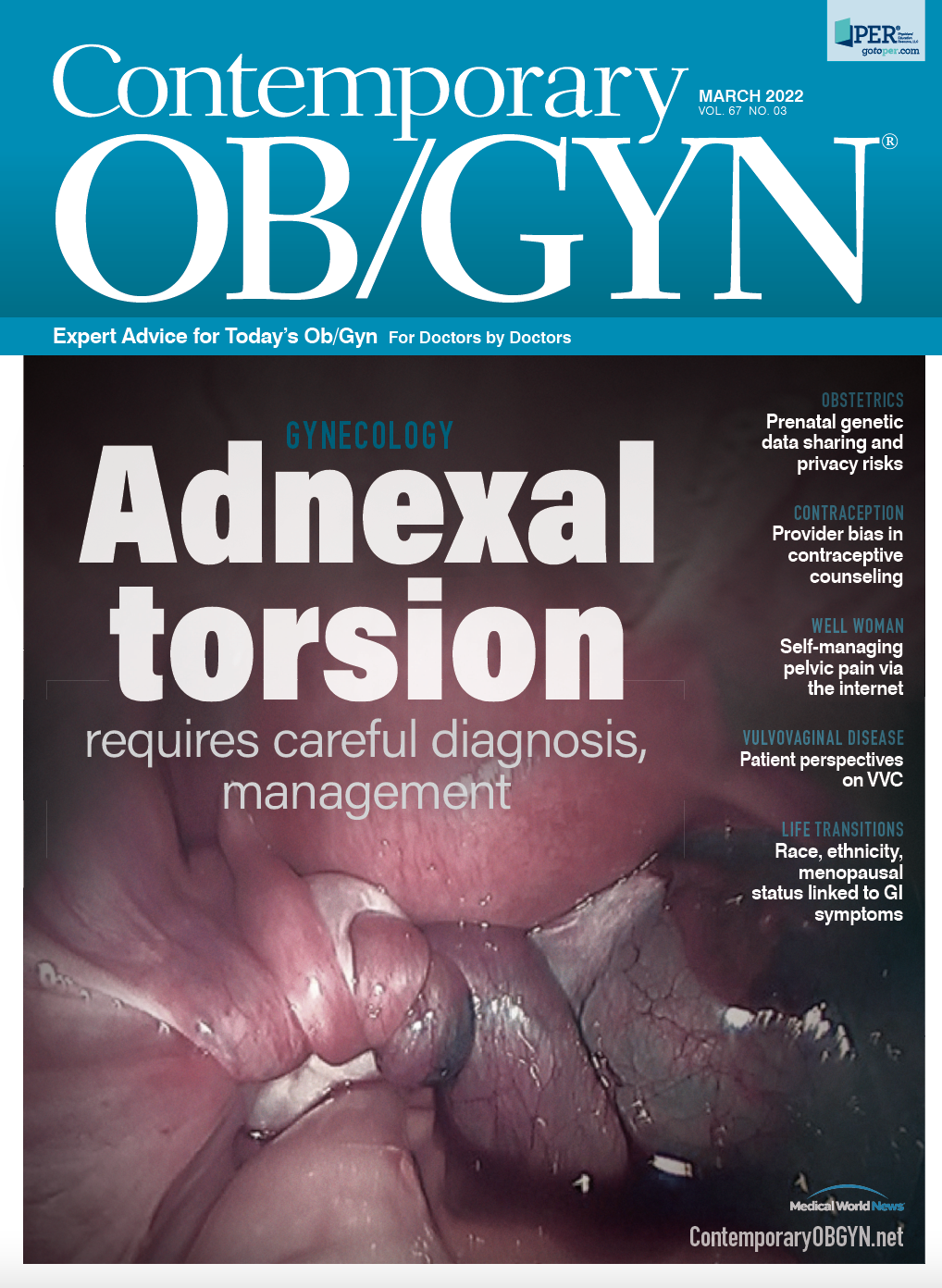Adnexal torsion requires careful diagnosis, management
Torsion of adnexal structures can occur in pregnant women, women post-hysterectomy, and postmenopausal women.
STEPHANIE M. CIZEK, MD, completed a fellowship in pediatric and adolescent gynecology and is now a clinical assistant professor in the Department of Obstetrics and Gynecology at Stanford School of Medicine in California.

Torsion of adnexal structures (including torsion of the ovary, fallopian tube, or both) is the fifth most common gynecologic emergency.1 It can occur at any age, although it is more likely in individuals 10 years and older, with an average being age 30 years.1-3 It is the sixth most common pediatric surgical emergency and is estimated to affect 5 of ever 100,000 individuals aged 1 to 20 years; 16% of pediatric torsion cases will occur prior to age 1 year.1 It can also occur in pregnant women, women post hysterectomy, and postmenopausal women.
Adnexal Torsion with Multiple Twists1
(Printed with permission from Paula Hillard, MD, and Elsevier.)
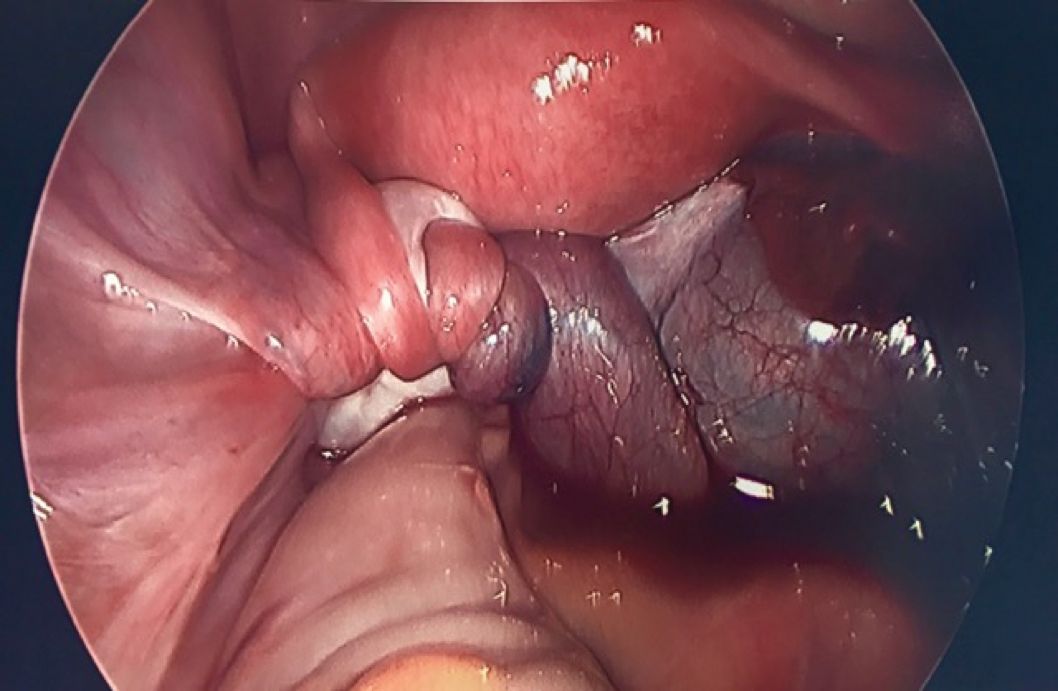
Why talk about torsion?
Both pediatric and adult patients are at risk for delayed or missed diagnosis of torsion. The main presenting symptoms of adnexal torsion are abdominal pain and nausea. Torsion pain is classically intermittent, leaving some patients clinically well appearing in between pain episodes. Imaging, particularly the presence of vascular flow to the adnexa, can provide false reassurance that torsion is not present. Providers may erroneously ascribe torsion pain to a “ruptured cyst” or “hemorrhagic cyst.” Finally, particularly in the pediatric and adolescent population, gynecologic etiologies of pain are often not considered.
How do patients with torsion present?
The presence of symptoms such as diarrhea, dysuria, abnormal vaginal discharge, and vulvovaginal pain/itching are not typical for torsion (Table 1).1,4,5 In neonates, torsion typically presents with nonspecific symptoms such as inconsolability or feeding intolerance, and the infant may have an abdominal mass on examination.1
Vomiting may be a good positive predictor of torsion. In a study of pediatric torsion, 83% of premenarchal patients and 100% of postmenarchal patients with a confirmed surgical diagnosis of torsion presented with vomiting as well as abdominal pain.4
Table 2. Patient Exam: Key Points for Adnexal Torsion1
PID, pelvic inflammatory disease.
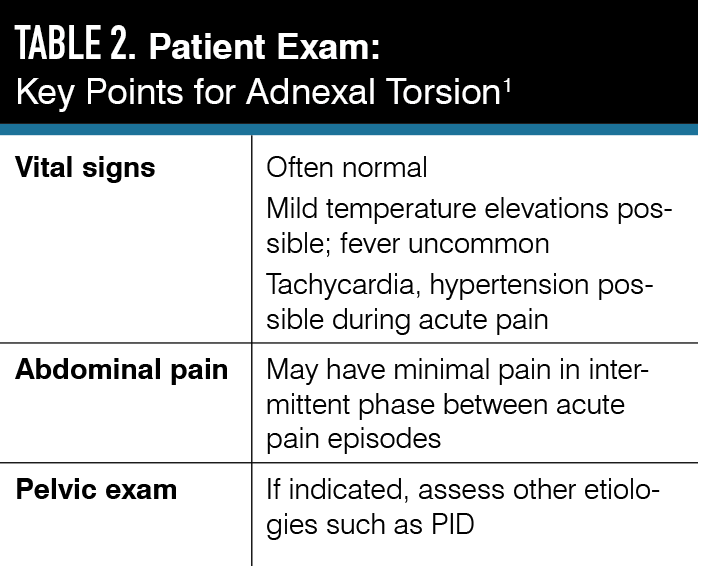
In all patients, a pelvic exam should be performed judiciously and is not necessary to diagnose torsion (Table 2).1 Pelvic exams may be most informative for sexually active patients to help distinguish pelvic inflammatory disease (which can also present as adnexal tenderness) from torsion (typically pain is worst in 1 adnexum and a mass may be palpable). In young or premenarchal patients, an external exam is needed if vulvar pathology or imperforate hymen are suspected.
What labs should be ordered?
Table 3. Laboratory Evaluation for Adnexal Torsion1,2
STI, sexually transmitted infection.
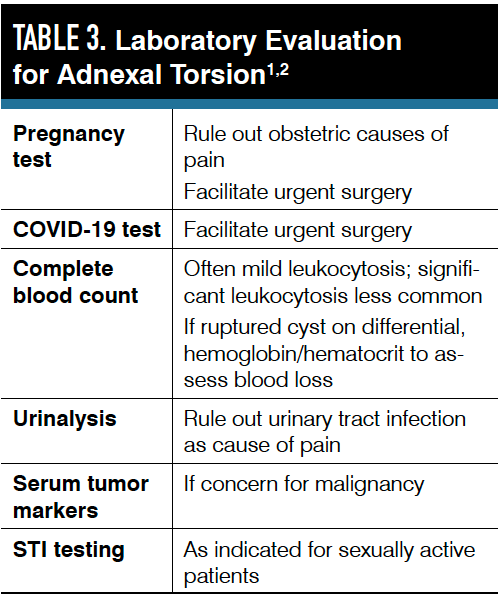
If malignancy is suspected, then serum tumor markers should be ordered, even if urgent surgical management is performed. Young patients are more likely to have a germ or stromal cell tumor and should have a quantitative β-human chorionic gonadotropin test, as well as tests for α-fetoprotein, lactate dehydrogenase, and inhibin A and inhibin B (Table 3).1,2 All patients (any age) should have a cancer antigen 125 test if there is concern about malignancy.1
What imaging tests should be done?
Clinically Indicated Pelvic Exams
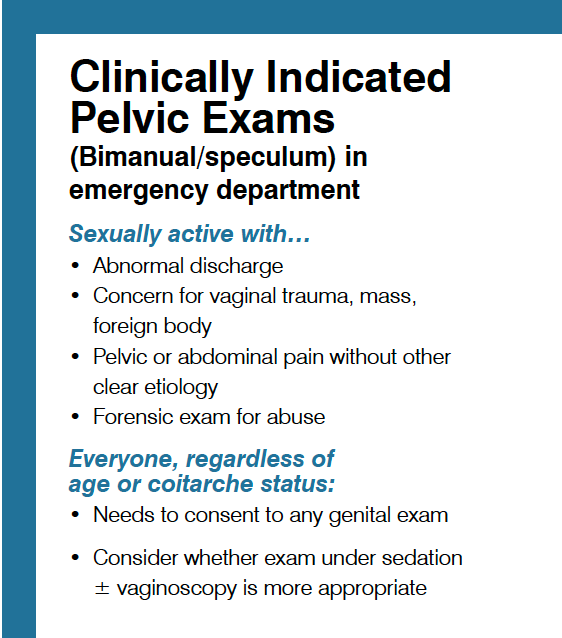
Pelvic ultrasound: Ultrasound is first line in the diagnosis of torsion and should be performed urgently in the emergency department setting when torsion is considered.2,6 Although transvaginal pelvic ultrasound results in better imaging of the adnexa, transabdominal ultrasound is typically used in the pediatric and adolescent presexually active population. A full bladder for transabdominal ultrasound may be difficult in patients with developmental delay or in young children.
CT and MRI: These may be good second-line diagnostic tools; however, both have limited differences in sensitivity/specificity compared with ultrasound, may delay evaluation, and may incur higher cost.2,6 CT is less preferred in pediatric patients because it involves ionizing radiation.
Table 4. Imaging Findings Concerning for Adnexal Torsion2,7,8
STI, sexually transmitted infection.
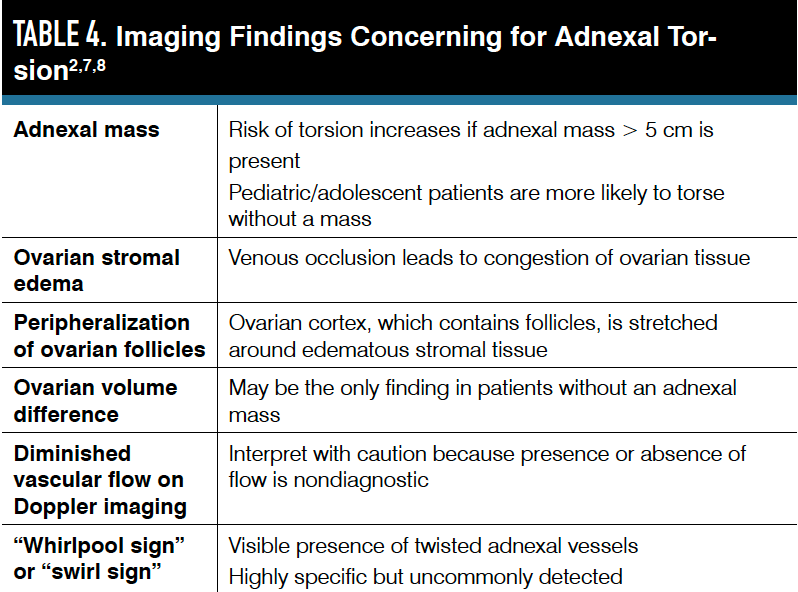
In a 2020 review, the addition of color Doppler imaging to ultrasound slightly improved both sensitivity and specificity but was not statistically significant.6 The presence of Doppler arterial and/or venous flow does not rule out a diagnosis of torsion, because patients with normal vascular flow per imaging may still have torsion (up to 60% in one study) (Table 4).2,7,8
Figure 2. Whirlpool sign on CT scan (arrow). This patient had bilateral paratubal cysts and right adnexal torsion on laparoscopy. (Printed with patient permission)
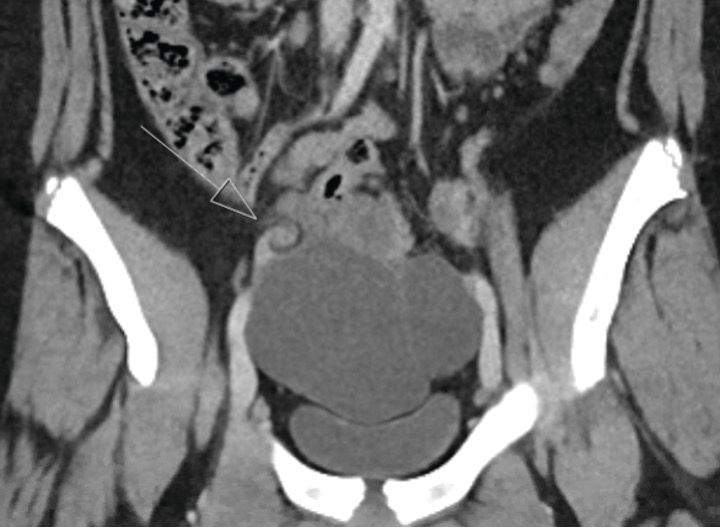
Pediatric and adolescent patients are more likely to have torsion in the absence of an ovarian cyst (up to 46%) compared with adults.2 In the absence of an adnexal mass, the only imaging finding may be volume differences from associated ovarian tissue edema of the torsed ovary or because a larger ovary itself may be a nidus for torsion.9 Volume differences are common and in torsion are typically notably significant (at least 2.5 times greater volume in the torsed ovary).9 Providers should use caution against overinterpreting volume differences in the setting of an adnexal mass: If there is a cyst, there is naturally a volume difference between the ovaries.
How is torsion managed?
Surgery is the gold standard. The definitive diagnosis and the management of adnexal torsion is done with urgent surgery, typically using laparoscopy. Approximately 50% of patients taken to the operating room because of concern for torsion will have torsion found intraoperatively.2
There is no duration of symptoms that reliably predicts ovarian viability. In one study with a median time of 16 hours from symptom onset to surgery, follow-up ultrasound showed normal follicular development in 91% of previously torsed ovaries.3 In another study, patients with viable-appearing ovaries had a median time from presentation to diagnosis of 12 hours, and a median time from symptom onset to presentation of 3 days.3 The lymphatic and venous obstructions are thought to occur prior to arterial blood flow obstruction, and some “loose” or “partial” torsion cases may have intermittent arterial blood flow, making it difficult to correlate pain onset with timing of true tissue ischemia.1,3 In a comparison of ovarian to testicular torsion, patients with suspected ovarian torsion waited 2.5 times as long for diagnostic imaging and 2.7 times as long to be taken to the operating room, and the salvage rate for the affected gonad was 14% for ovarian torsion and 30% for testicular torsion.10,11
Table 5. Key Points in Management of Adnexal Torsion1,12-14
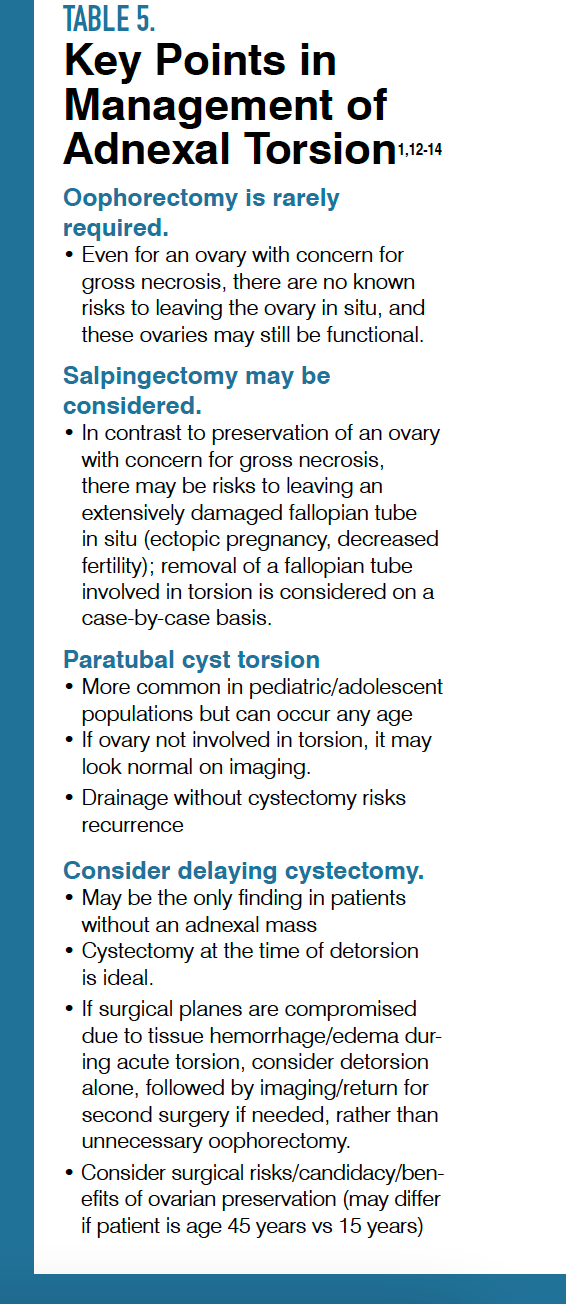
Nonsurgical management: The benefit of urgent surgical management when torsion is suspected is salvage of viable tubal and/or ovarian tissue, and improvement in patient pain. In select situations, such as a patient who is a poor surgical candidate, then after careful informed consent and shared decision-making discussion, medical management of pain without surgery (or with delayed, planned surgery) may be considered or even
recommended (Table 5).1,12-14
There is strong support for retaining torsed ovaries in situ even in the setting of gross signs of necrosis. Even an ovary appearing necrotic may continue to function, as measured by follicular development on ultrasound.1 Concerns regarding the increased risk of venous thromboembolism with detorsion or infection if necrotic tissue is left in situ have not been substantiated.1
Concern for malignancy is also often cited as a cause for oophorectomy, particularly in the pediatric population because at least 10% of pediatric ovarian masses are thought to be malignant.15 However, a recent large study found only a 1.8% malignancy rate among pediatric patients with ovarian torsion.15 A large multicenter study found that patients 10 years and younger (particularly those < 3 years old), those with public insurance, and those with chronic medical conditions were all more likely to undergo oophorectomy at the time of torsion, suggesting that many factors may play into surgical decision-making.16
Can oophoropexy prevent recurrence of torsion?
Right ovary SAG L-M
Peripheralization of follicles (hypoechoic rim) around the edematous stroma of the right ovary (outlined with dots). This patient had a right paratubal cyst and right adnexal torsion on laparoscopy. (Printed with patient permission)
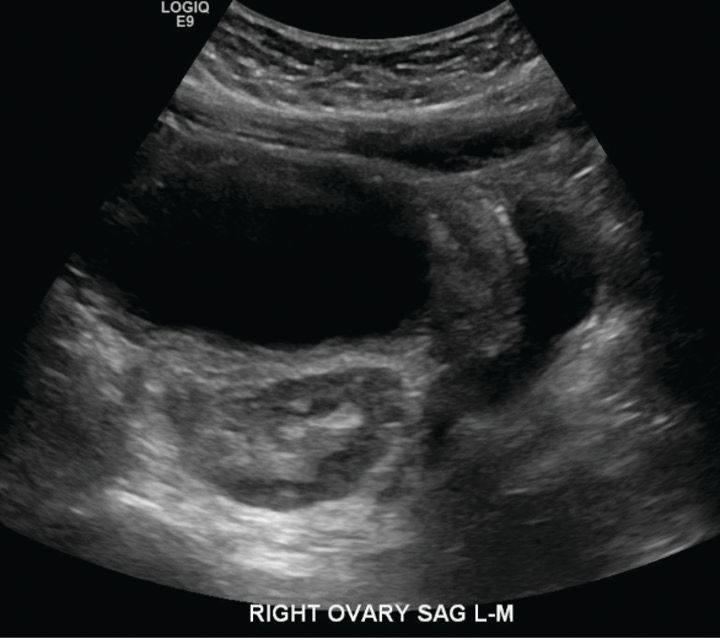
Recurrence is thought to be approximately 5% to 6%. Patients who initially had torsion of a normal ovary have the highest rates of recurrence (15% vs
3% in one study examining recurrence of idiopathic torsion vs torsion in the presence of an adnexal mass).17
Oophoropexy: The role of oophoropexy in preventing recurrence of torsion is controversial. Oophoropexy aims to reduce the risk of torsion either by fixing the ovary to a structure in the pelvis or shortening the utero-ovarian ligament. There are scant data comparing different oophoropexy techniques, which makes interpretation of efficacy data difficult. Recurrent torsion rates after oophoropexy are estimated to be between 9% and 17%. Because recurrence is highest in torsion of a normal ovary, this population, along with other patients at higher risk (those with bilateral torsion, recurrent torsion, prior oophorectomy, or anatomic risk factors such as long infundibulopelvic ligaments) may potentially benefit most from oophoropexy.17
Conclusion
A swift and accurate diagnosis of torsion requires a high index of suspicion, effective communication, and continuing education of all specialties involved. Gynecology and emergency department providers should keep torsion high on the differential and understand that imaging does not provide definitive evidence against torsion. Operating room staff and anesthesiologists should be aware of the urgent nature of torsion and the intermittent nature of symptoms that may make a patient appear less “urgent” for surgery. Overall, it is recommended that all providers keep torsion high on their differential.
References
1. Childress KJ, Dietrich JE. Pediatric ovarian torsion. Surg Clin North Am. 2017;97(1):209-221. doi:10.1016/j.suc.2016.08.008
2. Adnexal torsion in adolescents: ACOG Committee Opinion No, 783. Obstet Gynecol. 2019;134(2):e56-e63. doi:10.1097/AOG.0000000000003373
3. Robertson JJ, Long B, Koyfman A. Myths in the evaluation and management of ovarian torsion. J Emerg Med. 2017;52(4):449-456. doi:10.1016/j.jemermed.2016.11.012
4. Schwartz BI, Huppert JS, Chen C, Huang B, Reed JL. Creation of a composite score to predict adnexal torsion in children and adolescents. J Pediatr Adolesc Gynecol. 2018;31(2):132-137. doi:10.1016/j.jpag.2017.08.007
5. Brandt ML, Helmrath MA. Ovarian cysts in infants and children. Semin Pediatr Surg. 2005;14(2):78-85. doi:10.1053/j.sempedsurg.2005.01.002
6. Wattar B, Rimmer M, Rogozinska E, Macmillian M, Khan KS, Al Wattar BH. Accuracy of imaging modalities for adnexal torsion: a systematic review and meta-analysis. BJOG. 2021;128(1):37-44. doi:10.1111/1471-0528.16371
7. Ssi-Yan-Kai G, Rivain AL, Trichot C, et al. What every radiologist should know about adnexal torsion. Emerg Radiol. 2018;25(1):51-59. doi:10.1007/s10140-017-1549-8
8. Breech LL, Hillard PJA. Adnexal torsion in pediatric and adolescent girls. Curr Opin Obstet Gynecol. 2005;17(5):483-489. doi:10.1097/01.gco.0000179666.39548.78
9. Hartman SJ, Prieto JM, Naheedy JH, et al. Ovarian volume ratio is a reliable predictor of ovarian torsion in girls without an adnexal mass. J Pediatr Surg. 2021;56(1):180-182. doi:10.1016/j.jpedsurg.2020.09.031
10. Joudi N, Adams Hillard PJ. Adnexal torsion in a pediatric population: acute presentation with question of chronicity. Eur J Obstet Gynecol Reprod Biol. 2022;268:82-86. doi:10.1016/j.ejogrb.2021.11.435
11. Piper HG, Oltmann SC, Xu L, Adusumilli S, Fischer AC. Ovarian torsion: diagnosis of inclusion mandates earlier intervention. J Pediatr Surg. 2012;47(11):2071-2076. doi:10.1016/j.jpedsurg.2012.06.011
12. Casey RK, Damle LF, Gomez-Lobo V. Isolated fallopian tube torsion in pediatric and adolescent females: a retrospective review of 15 cases at a single institution. J Pediatr Adolesc Gynecol. 2013;26(3):189-192. doi:10.1016/j.jpag.2013.02.010
13. Melcer Y, Sarig-Meth T, Maymon R, Pansky M, Vaknin Z, Smorgick N. Similar but different: a comparison of adnexal torsion in pediatric, adolescent, and pregnant and reproductive-age women. J Womens Health (Larchmt). 2016;25(4):391-396. doi:10.1089/jwh.2015.5490
14. Lawrence AE, Minneci PC, Deans KJ. Ovarian masses and torsion: new approaches for ovarian salvage. Adv Pediatr. 2020;67:113-121. doi:10.1016/j.yapd.2020.03.010
15. Oltmann SC, Fischer A, Barber R, Huang R, Hicks B, Garcia N. Pediatric ovarian malignancy presenting as ovarian torsion: incidence and relevance. J Pediatr Surg. 2010;45(1):135-139. doi:10.1016/j.jpedsurg.2009.10.021
16. Lipsett SC, Haines L, Monuteaux MC, Hayes K, Michelson KA. Variation in oophorectomy rates for children with ovarian torsion across US children’s hospitals. J Pediatr. 2021;231:269-272.e1. doi:10.1016/j.jpeds.2020.12.019
17. Comeau IM, Hubner N, Kives SL, Allen LM. Rates and technique for oophoropexy in pediatric ovarian torsion: a single-institution case series. J Pediatr Adolesc Gynecol. 2017;30(3):418-421. doi:10.1016/j.jpag.2016.11.006
